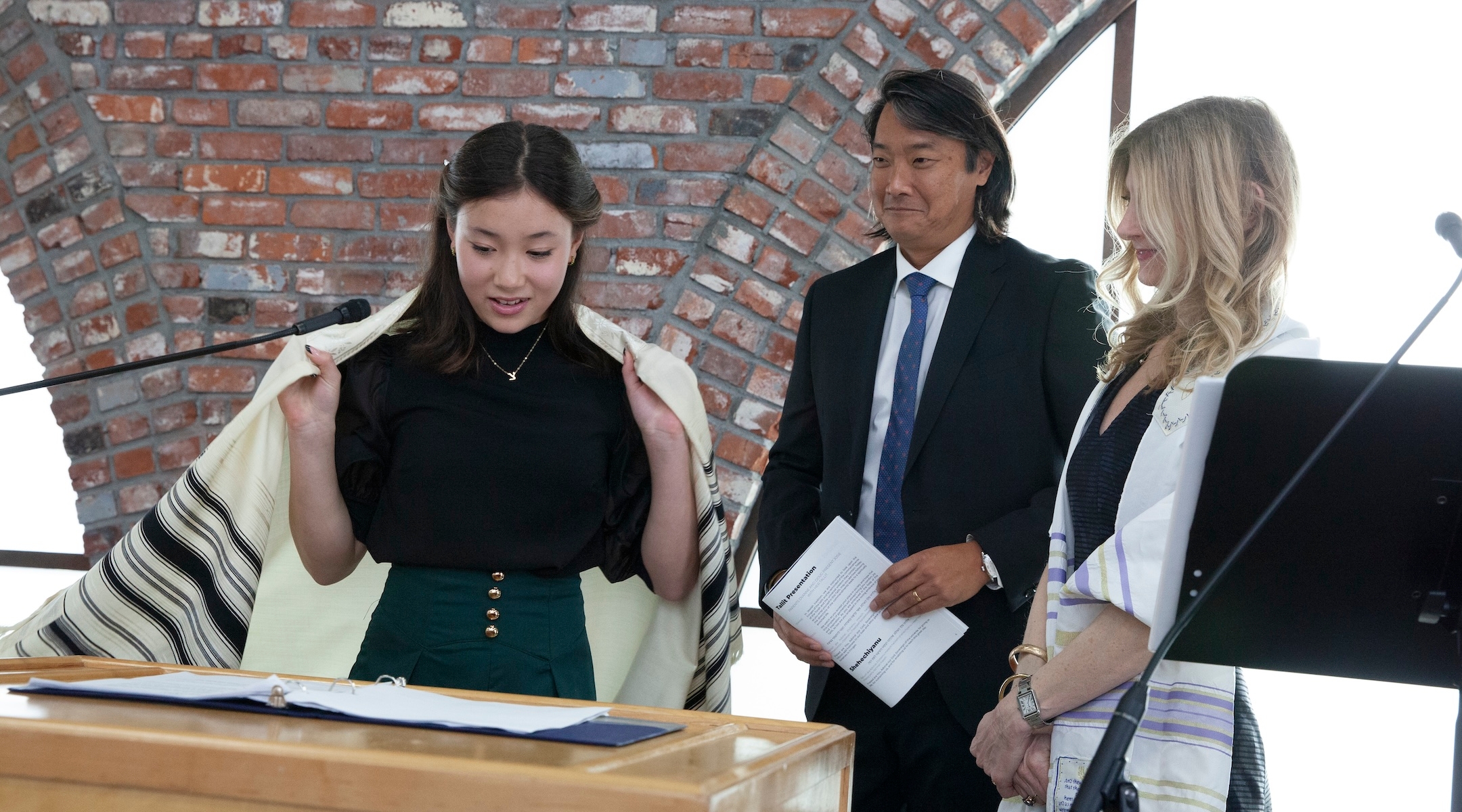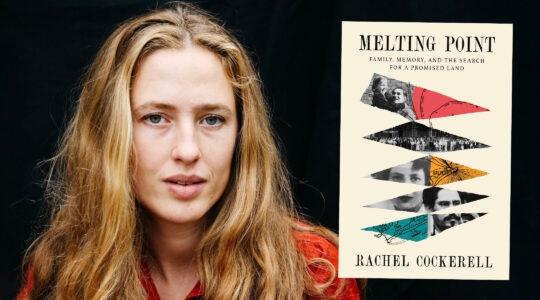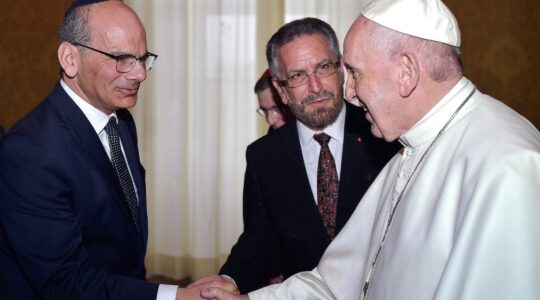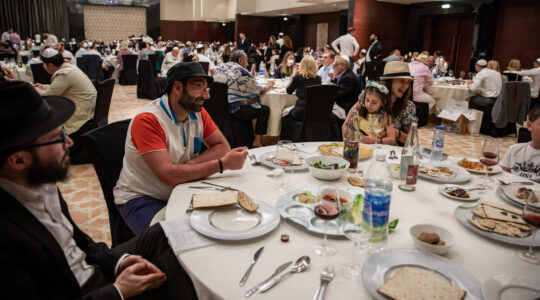This article was produced as part of JTA’s Teen Journalism Fellowship, a program that works with Jewish teens around the world to report on issues that affect their lives.
“Wait, you’re Jewish?”
Every time I hear that question, it feels like a doorway opening to a conversation I’ve had a million times before, and each time I tell people the same thing.
My dad is Korean, and my mom is Ashkenazi Jewish. I was raised in a Jewish household, where I celebrate every major Jewish holiday, had a bat mitzvah and spent six years learning Hebrew. Doing all of these things felt natural — what I should be doing as a Jew. Even though others might have their own questions for me based on how I look, I never questioned whether I should have a bat mitzvah or attend synagogue on the High Holy Days.
My Jewish experience has been steeped in family traditions and a Jewish community. My family hosts Passover seders and Yom Kippur break-fasts, surrounded by Jewish friends and family members. My dad’s brother’s family joins us for Passover each year, creating a blend of two distinct cultures. While this tradition brings our families together, my dad and his brother are second generation and don’t speak Korean or celebrate Korean holidays.
Based on how I look — my brown hair, brown almond eyes and tan skin — other people don’t see me as Jewish because it misaligns with how they think a Jewish person should look. The disconnect leads to some sort of cognitive dissonance, where their preconceived stereotypes about identity conflict with what they see. I know they are processing the information when they say, “Wait, you’re Jewish?” but to me it sounds like they are questioning the validity of my identity.
My Judaism is strongly connected to family — especially my mom. But, because I look Korean, it often feels tucked away under the surface. My Judaism is a part of my identity but it doesn’t inform my everyday life. I think because people don’t immediately see me as Jewish, it’s taken a toll on the way I see myself in the Jewish community.
On the other hand, being Korean is largely tied to my appearance. It’s the first thing people notice when they see me — which creates my own cognitive dissonance since I don’t really feel Korean beyond my appearance. I don’t celebrate any Korean holidays, I don’t speak Korean and I don’t have a strong connection to Korean traditions. My Korean experience feels more racial than cultural.
It feels like some sort of imposter syndrome in my own body. I navigate a space where my appearance tells one narrative, while my heritage tells another. Sometimes I feel like I straddle two worlds yet I don’t fully belong to either of them. In a way, I feel like I’m in some sort of cultural limbo.
However, my Korean and Jewish cultures are similar in that they are both heavily centered around family and food. My Korean grandmother — my Halmoni — connects me to my roots, like trying to learn Korean and having a love for Korean food. Similarly, my Jewish culture comes from what my mom and her family have taught me about our family history, and the Jewish traditions they have passed down.
However, despite this, I’ve never felt out of place in my Jewish community or at synagogue until recently.
On Kol Nidre last year, I went to synagogue with my mom and felt a sense of distance and detachment I’d never felt before. I looked around the room and I felt a distinct sense of “I don’t belong here.” I wondered why I noticed a disconnect this past year, rather than when I was a child regularly attending Hebrew lessons or a coming-of-age adult celebrating my bat mitzvah.
It dawned on me that I didn’t see a lot of people who looked like me. This was the first year going to synagogue with just my mom. I usually go with her and my older sister, who is now in college, so I always had someone who shared my identity and experiences. My mom doesn’t look like me, so she was a mirror to a feeling I had never experienced.
I often wonder how others navigate their multicultural identities and the pull of their various heritages. Conversations with other Jewish teens help me explore my multicultural identity within the Jewish community
Miyari Vazquez-Wright is half Jewish, half Taíno, the indigenous people of the Caribbean. She too, struggles with finding her place in the Jewish community because of her Taíno identity. “Outside of my sister, [I’ve known] two other people who are both a person of color and Jewish, so it’s just been hard to find my places on both sides,” Vazquez-Wright, 15, said.
While she does not identify as religiously Jewish, her connection to Judaism is deeply rooted in her family ties and the Los Angeles community she embraces. Like me, she’s felt how other people’s perceptions of her widen the distance between herself and Judaism.
This struggle with identity highlights the difficulties Jewish teens of color face in navigating our connection to our religion, especially when external perceptions can create barriers.
Vasquez-Wright often feels like an outsider at the places she worships, where people can be negative towards her identity. But she finds empowerment in combating the negativity.
“No matter what you say, I am still going to be a Jewish person. There’s power in that too,” she said.
Finding pride in Judaism takes time for some teens. Growing up, Bobby Ellenberg was self-conscious about standing out as an adopted Black Jew with white parents. But now, at 17, he enjoys going to synagogue in Los Angeles.
“When I was younger, it did weigh on me quite a bit,” Ellenberg said. “It was pretty noticeable in the class photos going to shul and the grade photos.”
He also faced adversity for not being “Black enough” because he didn’t grow up in a Black home. “I still have to deal with all the negative parts about being Black,” Ellenberg said. “I think that’s probably what it hurts the most.”
Once Ellenberg realized he was accepted, he recognized that the only person holding him back was himself.
The story young Jews of color tell themselves and tell others is an important part of acceptance, says Tani Prell, the creative director for Be’chol Lashon, a nonprofit raising awareness around racial and ethnic diversity in the Jewish community.
Last year, the organization partnered with the online site jGirls+ Magazine to feature the personal stories of Jewish teens of color. “I think this group understands on a very personal level how representation of diverse Jewish experiences in writing can help foster a sense of community and belonging,” Prell said.
Maybe this is the reason I wanted to be a part of the JTA Teen Fellowship. Telling my story is an instrument for me to celebrate my story and expand my perspective. In a world where diverse voices often go unheard, storytelling becomes even more crucial.
I don’t want to be part of a Judaism that doesn’t accept and allow me and Bobby and Miyari to be ourselves. I want to be part of a Judaism that does welcome us and allow us to come as we are.
Since last Kol Nidre, in talking to Miyari and Bobby and researching this article, I realized it doesn’t matter how others perceive us. It’s about how we see ourselves. I can’t change what others think about me, but I can change how I view myself.
JTA has documented Jewish history in real-time for over a century. Keep our journalism strong by joining us in supporting independent, award-winning reporting.





